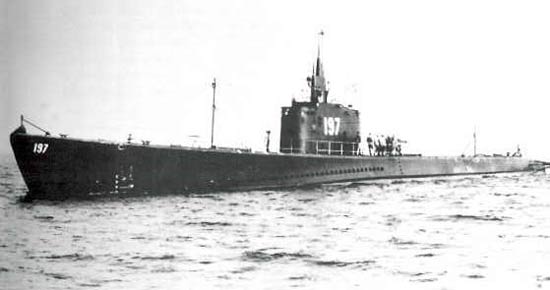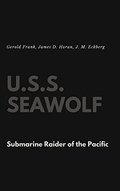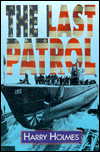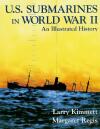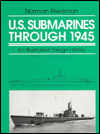| Navy | The US Navy |
| Type | Submarine |
| Class | Sargo |
| Pennant | 197 |
| Built by | Portsmouth Navy Yard (Kittery, Maine, U.S.A.) |
| Ordered | |
| Laid down | 27 Sep 1938 |
| Launched | 15 Aug 1939 |
| Commissioned | 1 Dec 1939 |
| Lost | 3 Oct 1944 |
| History | USS Seawolf (Lt.Cdr.Albert Marion Bontier, USN) was most likely sunk by mistake in a safety zone for American submarines off Morotai in position 02º32'N, 129º18'E, by aircraft from the escort carrier USS Midway (CVE 63) and the destroyer escort USS Richard M. Rowell (DE 403). The American forces in the area had just been attacked by a Japanese submarine and Seawolf was apparently mistaken for it. There were no survivors. |
Commands listed for USS Seawolf (197)
Please note that we're still working on this section
and that we only list Commanding Officers for the duration of the Second World War.
| Commander | From | To | |
| 1 | Lt.Cdr. Frederick Burdett Warder, USN | 1 Dec 1939 | 18 Jan 1943 |
| 2 | T/Cdr. Royce Lawrence Gross, USN | 18 Jan 1943 | early 1944 |
| 3 | T/Lt.Cdr. Richard Barr Lynch, USN | early 1944 | 30 Jul 1944 |
| 4 | T/Cdr. Albert Marion Bontier, USN | 30 Jul 1944 | 3 Oct 1944 (+) |
You can help improve our commands section
Click here to Submit events/comments/updates for this vessel.
Please use this if you spot mistakes or want to improve this ships page.
Notable events involving Seawolf include:
8 Dec 1941
USS Seawolf (Lt.Cdr. F.B. Warder) departed from Manila for her 1st war patrol. She was ordered to patrol off the San Bernardino Strait.
14 Dec 1941
USS Seawolf (Lt.Cdr. F.B. Warder) hits the Japanese seaplane carrier Sanyo Maru (8360 GRT, offsite link) with one torpedo off Aparri, Philippines. Unfortunately the torpedo fails to explode.
26 Dec 1941
USS Seawolf (Lt.Cdr. F.B. Warder) ended her 1st war patrol at Manila.
31 Dec 1941
USS Seawolf (Lt.Cdr. F.B. Warder) departed from Manila for her 2nd war patrol.
9 Jan 1942
USS Seawolf (Lt.Cdr. F.B. Warder) ended her 2nd war patrol at Darwin, Australia.
16 Jan 1942
USS Seawolf (Lt.Cdr. F.B. Warder) leaves Darwin for her 3th war patrol loaded with some 40 tons of .50 calibre anti-aircraft ammunition for use by American forces on Corregidor.
28 Jan 1942
USS Seawolf (Lt.Cdr. F.B. Warder) unloads the ammunition at Corregidor. She takes on board spare torpedo's and 25 officers and men. She then departed from for Surabaya, Java, Netherlands East Indies.
15 Feb 1942
USS Seawolf (Lt.Cdr. F.B. Warder) departed from Surabaya for her 4th war patrol. She was ordered to patrol in the Java Sea.
19 Feb 1942
Battle of Badoeng Strait
It was expected that the Japanese would soon land (night of 19/20 February 1942) on the south-east coast of Bali (Badoeng Strait). Rear-Admiral Doorman therefore wanted to attack them in three waves. The first wave came from Tjilatjap on the south coast of Java and consisted of the Dutch light cruisers HrMs De Ruyter (Cdr. E.E.B. Lacomblé, RNN and flagship of Rear-Admiral K.W.F.M. Doorman, RNN) and HrMs Java (Capt. P.B.M van Straelen, RNN), escorted by the Dutch destroyers HrMs Piet Hein (Lt.Cdr. J.M.L.I. Chompff, RNN) and HrMs Kortenaer (Lt.Cdr. A. Kroese, RNN) as well as the US destroyers USS John D. Ford (Lt.Cdr. J.E. Cooper, USN) and USS Pope (Lt.Cdr. W.C. Blinn, USN). However while leaving Tjilatjap in the evening of the 18th the Dutch destroyer Kortenaer grounded and was only able to get of at high tide therefore was no longer part of this force.
The second wave was made up of the Dutch light cruiser HrMs Tromp (Cdr. J.B. de Meester, RNN) and four US destroyers; USS Stewart (Lt.Cdr. H.P. Smith, USN), USS Parrott (Lt.Cdr. J.N. Hughes, USN), USS Pillsbury (Lt.Cdr. H.C. Pound, USN) and USS John D. Edwards (Lt.Cdr. H.E. Eccles, USN). They sailed from Surabaya in the afternoon of the 19th
Finally the third wave was made up of the Dutch Motor Torpedo Boats; HrMs TM-4 (Lt. J.E. Gobée, RNN), HrMs TM-5 (S.Lt. E.J. Hoeksel, RNN), HrMs TM-6 (S.Lt. P. van Rees, RNN), HrMs TM-8 (Lt. J.G. Treffers, RNN), HrMs TM-9 (Lt. J.A. van Beusekom, RNN), HrMs TM-10 (S.Lt. J.W. Boon, RNN(R)), HrMs TM-11 (S.Lt. A.A.F. Schmitz, RNN), HrMs TM-15 (Lt. H.C. Jorissen, RNN). HrMs TM-13 (?) was also part of this force but acted as 'rescue boat'. Shortly after their sailing from Surabaya in the evening of the 18th HrMs TM-6 was forced to return due to engine trouble. These Motor Torpedo Boats proceeded through Strait Bali and anchored in three bay's on the Java side to refuel which took the whole day. In the evening of the 19th they departed for Badoeng Strait.
The Japanese attack on Bali was carried out by two transport ships Sasako Maru (7180 GRT, built 1941) and Sagami Maru (7189 GRT, built 1940). They had on board part of the Imperial Japanese Army’s 48th Infantry Division and had departed Makassar for Bali during the night of 17/18 February. They were escorted by four destroyers; Asashio (Lt.Cdr. G. Yoshii), Oshio (Cdr. K. Kikkawa) Arashio (Cdr. H. Kuboki) and Michishio (Lt.Cdr. M. Ogura). Distant cover was provided by the light cruiser Nagara (Capt T. Naoi, flagship of Rear-Admiral K. Kubo) escorted by three destroyers Hatsushimo (Lt.Cdr. S. Kohama), Nenohi (Lt.Cdr. T. Chihagi) and Wakaba (Lt.Cdr. M. Kuroki).
The Japanese landed around 0200/19 on the south coast of Bali. The transports were attacked unsuccessfully by the American submarine USS Seawolf. Seawolf herself was then counter attacked with depth charges by the destroyers but managed to escape.
During the day the Japanese transports were attacked from the air and the Sagami Maru was damaged. She left the landing zone escorted by the destroyers Arashio and Michishio. The undamaged Sasako Maru remained in the landing zone to pick up the landing barges. The destroyers Asashio and Oshio remained with her.
The allied first attack wave arrived south of Bali around 2130/19. A line was then formed in the order, HrMs De Ruyter, HrMs Java, HrMs Piet Hein, USS John D. Ford and finally USS Pope. Speed was increaded to 27 knots and they proceeded up Badoeng Strait. Around 2230 hours HrMs De Ruyter and HrMs Java opened fire on the Japanese which were taken by surprise. The Asashio turned a searchlight on which was quickly taken out by a salvo from the Java. The Dutch cruisers claimed heavy damage on the enemy but according to Japanese reports on the battle damage was only minor and after being initially taken by surprise the Japanese soon counter attacked. By that time however the Dutch cruisers had moved on.
The Allied destroyers were further behind the cruisers then intended and now arrived on the scene. Piet Hein was a little ahead of the US destroyers and opened fire with her 4.7” guns and also fired two torpedoes. Shortly afterwards two more torpedoes were fired but none found their intended target. Piet Hein then turned around towards the US destroyers with the intention to attack the Japanese again. While doing so her smoke generator was started. It is not completely clear but it is possible that one of these US destroyers then engaged Piet Hein with gunfire thinking she was Japanese. It is also possible that it were the Japanese that engaged Piet Hein. At this time Piet Hein was hit several times, resulting in her to come to a stop. After about 15 minutes Piet Hein was illuminated by a Japanese searchlight and taken under fire. The crew was ordered to abandon the doomed destroyer and she soon sank.
USS John D. Ford and Pope sighted a Japanese transport vessel (this must have been the Sasaga Maru) and what they thought to be a Japanese cruiser but this must have been the destroyer Oshio. They launched torpedoes (Ford – three, Pope - five) and turned away. Asashio and Oshio when went after them. The Americans thought they faced a very powerful enemy, even heavy cruisers were thought to be present. Both destroyers then retired to the south-east to return to Tjilatjap. Shortly afterwards they heard gunfire. This gunfire was coming from both Japanese destroyer that were now engaging each other by mistake. After a few minutes the mistake was noticed and both Japanese destroyer retired up the Strait to the north.
Meanwhile the Allied second attack wave was nearing the scene of the action. They had arrived south of Bali around 0100/20. The four US destroyers were ahead of the Tromp. It was intended that the four US destroyer would enter Badoeng Strait and attack with torpedoes first and that the Tromp would come behind them to finish off the Japanese after the confusion of the torpedo attack. During the torpedo attack a total of fifteen torpedoes were fired, six each by USS Stewart and USS Pope and three by USS Pillsbury. Their targets, Asashio and Oshio were not hit and both Japanese destroyers now went after their attackers. Stewart was then hit with gunfire. The US destroyers then set course to the east to leave Badoeng Strait. Now Tromp went in. Soon she was illuminated by a searchlight and the Japanese opened fire. Thy obtained eleven hits on the Tromp causing heavy damage to the Dutch cruiser. The Oshio on her turn was seriously damaged by the Tromp. The action was over around 0215/20 and Tromp retired from the Strait to the north-east. When north of Bali she went to full speed and returned to Surabaya for repairs.
Japanese Rear-Admiral Kubo, on board the Nagara, had meanwhile ordered the Arashio and Michishio to return to Badoeng Strait (Nagara and her three escorting destroyers were too far off). When the two Japanese destroyers entered the Strait they encountered the four US destroyers. Both sides launched torpedoes but all missed their intended targets and then a gunfight was started. During this gunfight the Michishio was heavily damaged and in the end she had to be towed back to Makassar. The US destroyer meanwhile continued to retire from the area.
The third wave then entered the Strait. The Dutch MTB’s had seen the second wave attacking but when they entered Badoeng Strait the Japanese were not sighted and they left without being able to fire torpedoes.
The Allies were at that time under the impression that they had obtained a victory. They thought to have sunk a Japanese cruiser and have damaged two more cruisers and two destroyers. This was not the case, one Japanese destroyer was heavily damaged and one seriously. In return the Japanese sank a Dutch destroyer and damaged the Dutch cruiser Tromp heavily. As the Dutch naval base at Surabaya was now under daily air attack it was deemed wise to sent the Tromp to Australia for repairs.
1 Apr 1942
USS Seawolf (Lt.Cdr. F.B. Warder) torpedoed and damaged the Japanese light cruiser Naka (offsite link) off Christmas Island in position 10°00'S, 105°00'E.
7 Apr 1942
USS Seawolf (Lt.Cdr. F.B. Warder) ended her 4th war patrol at Fremantle, Australia.
12 May 1942
USS Seawolf (Lt.Cdr. F.B. Warder) departed from Fremantle for her 5th war patrol. She was ordered to patrol in the Philippines.
15 Jun 1942
USS Seawolf (Lt.Cdr. F.B. Warder, USN) torpedoed and sank the Japanese auxiliary gunboat Nampo Maru (1206 GRT, built 1940) off Corregidor, Philippines in position 14°20'N, 120°20'E.
2 Jul 1942
USS Seawolf (Lt.Cdr. F.B. Warder) ended her 5th war patrol at Fremantle.
25 Jul 1942
USS Seawolf (Lt.Cdr. F.B. Warder) departed from Fremantle for her 6th war patrol. She was ordered to patrol in the Sulu and Celebes Seas.
14 Aug 1942
USS Seawolf (Lt.Cdr. F.B. Warder) torpedoed and sank the Japanese merchant passenger-cargo ship Hachigen Maru (3113 GRT) in the Sibitu Passage in position 05°07'N, 119°37'E.
25 Aug 1942
USS Seawolf (Lt.Cdr. F.B. Warder) torpedoed and sank the Japanese transport ship Showa Maru (1349 GRT) off the north-east coast of Borneo in position 03°55'N, 118°59'E.
15 Sep 1942
USS Seawolf (Lt.Cdr. F.B. Warder) ended her 6th war patrol at Fremantle.
1 Oct 1942
USS Seawolf (Lt.Cdr. F.B. Warder) departed from Fremantle for her 7th war patrol. She was ordered to patrol off the Davao Gulf, southern Philippines.
2 Nov 1942
USS Seawolf (Lt.Cdr. F.B. Warder) torpedoed and sank the Japanese water tender Gifu Maru (2933 GRT) west-south-west of Cape San Augustin, Mindoro, Philippines in position 06°14'N, 126°07'E.
3 Nov 1942
USS Seawolf (Lt.Cdr. F.B. Warder) torpedoed and sank the Japanese troop transport Sagami Maru (7189 GRT) off Davao, Philippines in position 07°02'N, 125°33'E.
8 Nov 1942
USS Seawolf (Lt.Cdr. F.B. Warder) torpedoed and sank Japanese auxiliary gunboat Keiko Maru (2929 GRT) off Cape San Augustin, Mindanao, Philippines in position 06°22'N, 126°03'E.
1 Dec 1942
USS Seawolf (Lt.Cdr. F.B. Warder) ended her 7th war patrol at Pearl Harbor. She was ordered to the Mare Island Navy Yard for an overhaul.
3 Apr 1943
With her overhaul completed USS Seawolf (Lt.Cdr. R.L. Gross) departed from Pearl Harbor for her 8th war patrol. She was ordered to patrol of the Bonin Islands.
15 Apr 1943
USS Seawolf (Lt.Cdr. R.L. Gross) torpedoed and sank Japanese troop transport Kaihei Maru (4575 GRT) about 275 nautical miles south-southwest of Marcus Island in position 21°15'N, 152°00'E.
19 Apr 1943
USS Seawolf (Lt.Cdr. R.L. Gross) torpedoed sank Japanese depot ship Banshu Maru No.5 (389 GRT) off the Bonin Islands in position 26°15'N, 139°35'E.
23 Apr 1943
USS Seawolf (Lt.Cdr. R.L. Gross) torpedoed and sank the Japanese Patrol Boat No.39 off the east central coast of Formosa in position 23°45'N, 122°45'E.
3 May 1943
USS Seawolf (Lt.Cdr. R.L. Gross) ended her 8th war patrol at Midway.
17 May 1943
USS Seawolf (Lt.Cdr. R.L. Gross) departed from Midway for her 9th war patrol. She was ordered to patrol in the East China Sea.
20 Jun 1943
USS Seawolf (Lt.Cdr. R.L. Gross) torpedoed and sank the Japanese merchant Shojin Maru (4739 GRT) in the Formosa Strait position 24°39'N, 118°58'E.
12 Jul 1943
USS Seawolf (Lt.Cdr. R.L. Gross) ended her 9th war patrol at Pearl Harbor.
14 Aug 1943
USS Seawolf (Lt.Cdr. R.L. Gross) departed from Pearl Harbor for her 10th war patrol. Once again she was ordered to patrol in the East China Sea.
31 Aug 1943
USS Seawolf (Lt.Cdr. R.L. Gross) torpedoed and damaged the Japanese torpedo boat Sagi (offsite link) and torpedoed and sank the transport ship Shoto Maru (5253 GRT) and the Japanese merchant Kokko Maru (5486 GRT) in the East China Sea position 28°30'N, 123°05'E.
1 Sep 1943
USS Seawolf (Lt.Cdr. R.L. Gross) torpedoed and damaged the Japanese transport ship Fusei Maru (2256 GRT) in the East China Sea about 105 nautical miles south-west of Fukue, Japan in position 31°28'N, 127°24'E. She later finished off the damaged Japanese ship with gunfire.
15 Sep 1943
USS Seawolf (Lt.Cdr. R.L. Gross) ended her 10th war patrol when she returned to base.
5 Oct 1943
USS Seawolf (Lt.Cdr. R.L. Gross) left base for her 11th war patrol. She was ordered to patrol in the South China Sea.
29 Oct 1943
USS Seawolf (Lt.Cdr. R.L. Gross) torpedoed and sank the Japanese merchant Wuhu Maru (3222 GRT) off Swatow, China in position 22°28'N, 116°10'E.
4 Nov 1943
USS Seawolf (Lt.Cdr. R.L. Gross) torpedoed and sank the Japanese merchant Kaifuku Maru (3177 GRT) about 90 nautical miles south-south-west of Hong Kong in position 21°22'N, 113°20'E.
9 Nov 1943
USS Seawolf (Lt.Cdr. R.L. Gross) unsuccessfully attacked the Japanese transport ship Hokuriku Maru (8359 GRT) in the Luzon Strait in position 20°38'N, 118°33'E.
27 Nov 1943
USS Seawolf (Lt.Cdr. R.L. Gross) ended her 11th war patrol at Pearl Harbor.
22 Dec 1943
USS Seawolf (Lt.Cdr. R.L. Gross) departed from Pearl Harbor for her 12th war patrol. She was ordered to patrol in the East China Sea.
10 Jan 1944
While on patrol in the East China Sea west off Okinawa, USS Seawolf (Lt.Cdr. R.L. Gross) torpedoed and sank the Japanese transport ship Asuka Maru (7523 GRT) in position 27°30'N, 127°45'E and the Japanese merchant Getsuyo Maru (6440 GRT) in position 27°10'N, 127°28'E.
11 Jan 1944
USS Seawolf (Lt.Cdr. R.L. Gross) torpedoed and sank the Japanese transport ship Yahiko Maru (5747 GRT) about 50 nautical miles north of Naha, Okinawa in position 27°10'N, 127°28'E.
14 Jan 1944
USS Seawolf (Lt.Cdr. R.L. Gross) torpedoed and sank the Japanese tanker Yamazuru Maru (3651 GRT) about 300 nautical miles north-east of Okinawa in position 25°00'N, 132°00'E.
16 Jan 1944
USS Seawolf (Lt.Cdr. R.L. Gross) torpedoed and damaged the transport ship Tarushima Maru (4865 GRT) in the Philippine Sea in position 23°00'N, 135°00'E. USS Whale later finishes off the damaged Japanese ship in position 22°50'N, 135°40'E.
27 Jan 1944
USS Seawolf (Lt.Cdr. R.L. Gross) ended her very successful 12th war patrol at Pearl Harbor. She was ordered to the Hunters Point Navy Yard for an overhaul.
4 Jun 1944
With her overhaul completed USS Seawolf (Lt.Cdr. R.B. Lynch) left Pearl Harbor for her 13th war patrol. She was ordered to photograph Peleliu Island in the Palau Islands.
7 Jul 1944
USS Seawolf (Lt.Cdr. R.B. Lynch) ended her 13th war patrol at Pearl Harbor. She was now sent to Darwin, Australia. Her 14th war patrol was a special mission to Tawitawi in the Sulu Archipelago.
21 Sep 1944
USS Seawolf (Lt.Cdr. A.M. Bontier) left Brisbane for her 15th war patrol. She was ordered to transport stores and Army personnel to the east coast of Samar. Seawolf called at Manus on 29 September.
Media links
|
|
|
|
As an Amazon Associate uboat.net earns a commission from qualifying purchases.

